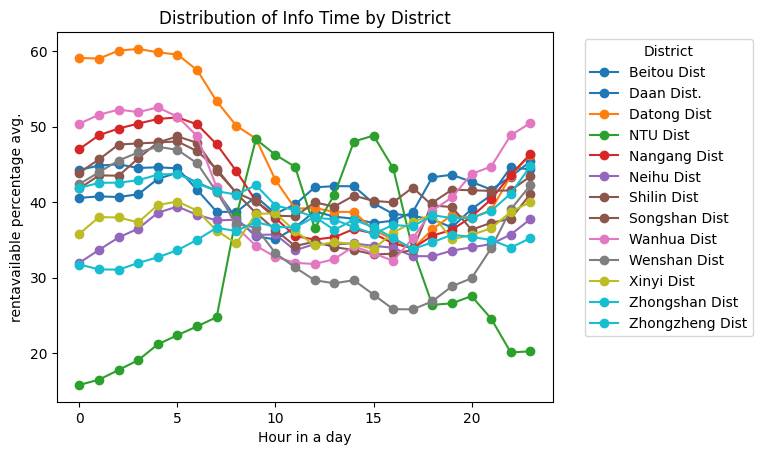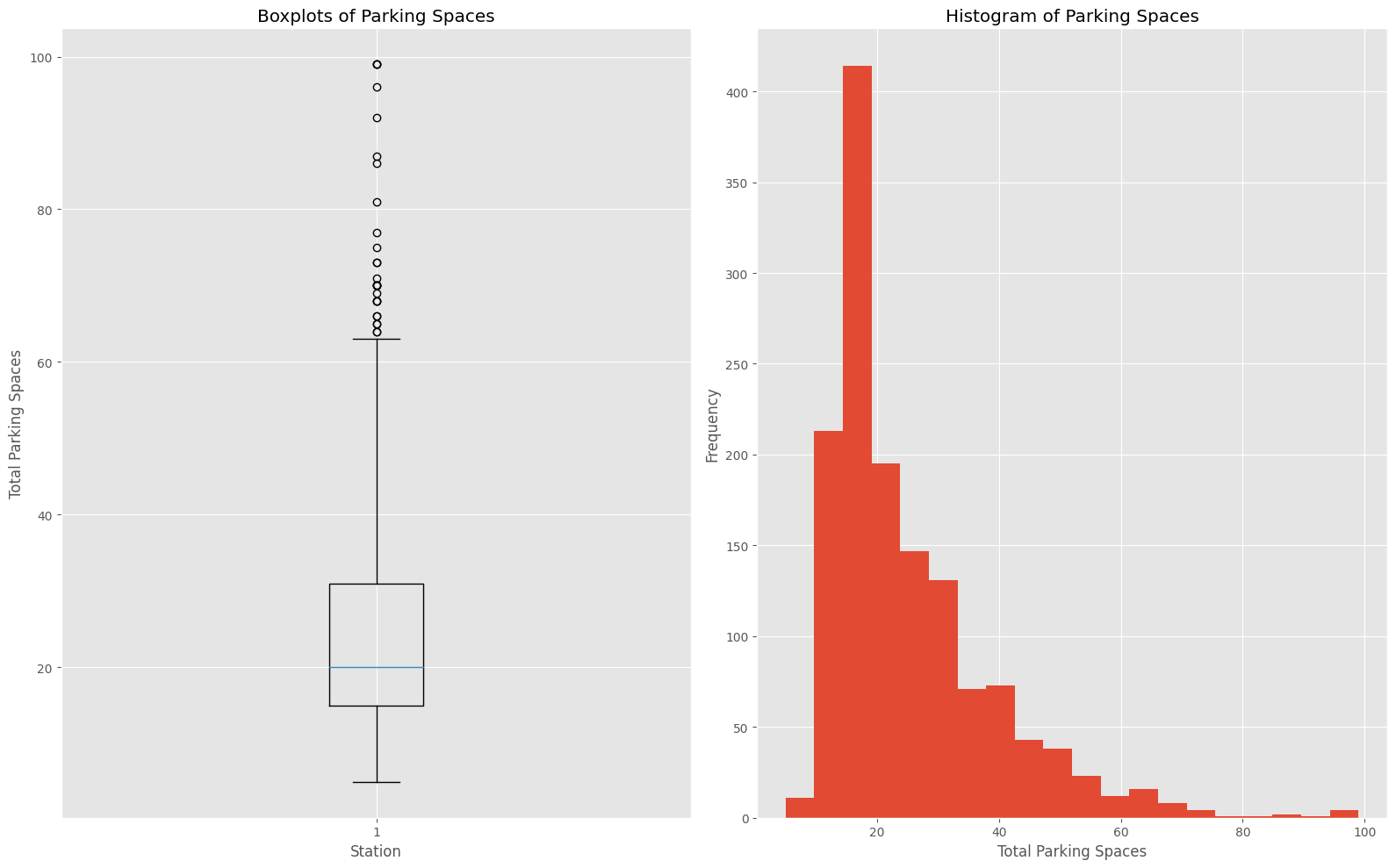Data analysis books for YouBike services#
We require to install pandas, metplotlib and seaborn in the virtual environment.
import pandas as pd
import numpy as np
import os
from matplotlib import pyplot as plt
pd.set_option('display.max_rows',5)
pd.set_option('large_repr', 'info')
li = []
for dirname, _, filenames in os.walk('./data/'):
for filename in filenames:
df = pd.read_csv(dirname+filename, index_col=None, header=0)
li.append(df)
# read data here
bikecsv = pd.concat(li, axis=0, ignore_index=True)
bikecsv
<class 'pandas.core.frame.DataFrame'> RangeIndex: 814262 entries, 0 to 814261 Data columns (total 11 columns): # Column Non-Null Count Dtype --- ------ -------------- ----- 0 _id 814262 non-null object 1 station_no 814262 non-null int64 2 station_name 814262 non-null object 3 station_name_en 814262 non-null object 4 district 814262 non-null object 5 district_en 814262 non-null object 6 total 814262 non-null int64 7 rentAvailable 814262 non-null int64 8 returnAvaiable 814262 non-null int64 9 updated_time 814262 non-null object 10 info_time 814262 non-null object dtypes: int64(4), object(7) memory usage: 68.3+ MB
Before analysis, it is necessary to know the columns in the CSV data#
Here is the table showing the meanings or types of data:
Column Name |
Type (Numerical/Category) |
Nullable |
Description |
|---|---|---|---|
_id |
Categorical |
non-null |
UUID generated by MongoDB, also a serial ID |
station_no |
Categorical |
non-null |
Serial Number |
station_name |
Categorical |
non-null |
Station name |
district |
Categorical |
non-null |
Stations in which districts |
total |
Numerical |
non-null |
Total = used + empty |
rentAvailable |
Numerical |
non-null |
Available rental seats in stations |
returnAvailable |
Numerical |
non-null |
Available return seats in stations |
updated_time |
Date String |
non-null |
Date-time string in TZ GMT+8 |
info_time |
Date String |
non-null |
Date-time string in TZ GMT+8 |
Additionally, info_time can be categorized as workday or weekend for analysis.
After identifying the meanings of data columns, here is a checklist to process the dataframe:#
Define the outliers according to the description of columns
Identify and remove erroneous data in the CSV
Process date strings with pandas
Drop some serial ID columns
Drop some categorical columns from the dataset:#
# drop column here axis=0 indicates data in row, axis=1 indicates data in column
bikecsv = bikecsv.drop(axis=1, columns=['_id', 'station_no','station_name','district'])
bikecsv
<class 'pandas.core.frame.DataFrame'> RangeIndex: 814262 entries, 0 to 814261 Data columns (total 7 columns): # Column Non-Null Count Dtype --- ------ -------------- ----- 0 station_name_en 814262 non-null object 1 district_en 814262 non-null object 2 total 814262 non-null int64 3 rentAvailable 814262 non-null int64 4 returnAvaiable 814262 non-null int64 5 updated_time 814262 non-null object 6 info_time 814262 non-null object dtypes: int64(3), object(4) memory usage: 43.5+ MB
In normal cases, we need to omit erroneous data:#
As defined in the column descriptions, total is equal to rentAvailable plus returnAvailable.
filtered = bikecsv.loc[bikecsv['total'] == bikecsv['rentAvailable']+bikecsv['returnAvaiable'],:]
print('Correct data Percentage: '+str(round(len(filtered)/len(bikecsv),4) * 100)+'%')
Correct data Percentage: 86.86%
Transforming date strings into the timestamp data type#
print('Let\'s show some insight of date')
## convert datetime strings to datetime formats
filtered['info_time'] = pd.to_datetime(filtered['info_time'],format='%Y-%m-%d %H:%M:%S')
filtered['updated_time'] = pd.to_datetime(filtered['updated_time'],format='%Y-%m-%d %H:%M:%S')
## calculate time difference between station updated time and current time
timeDiff = (filtered['info_time'] - filtered['updated_time']) / pd.Timedelta(minutes=1)
filtered['TimeDiff'] = timeDiff
Let's show some insight of date
/tmp/ipykernel_1902/2368680856.py:4: SettingWithCopyWarning:
A value is trying to be set on a copy of a slice from a DataFrame.
Try using .loc[row_indexer,col_indexer] = value instead
See the caveats in the documentation: https://pandas.pydata.org/pandas-docs/stable/user_guide/indexing.html#returning-a-view-versus-a-copy
filtered['info_time'] = pd.to_datetime(filtered['info_time'],format='%Y-%m-%d %H:%M:%S')
/tmp/ipykernel_1902/2368680856.py:5: SettingWithCopyWarning:
A value is trying to be set on a copy of a slice from a DataFrame.
Try using .loc[row_indexer,col_indexer] = value instead
See the caveats in the documentation: https://pandas.pydata.org/pandas-docs/stable/user_guide/indexing.html#returning-a-view-versus-a-copy
filtered['updated_time'] = pd.to_datetime(filtered['updated_time'],format='%Y-%m-%d %H:%M:%S')
/tmp/ipykernel_1902/2368680856.py:10: SettingWithCopyWarning:
A value is trying to be set on a copy of a slice from a DataFrame.
Try using .loc[row_indexer,col_indexer] = value instead
See the caveats in the documentation: https://pandas.pydata.org/pandas-docs/stable/user_guide/indexing.html#returning-a-view-versus-a-copy
filtered['TimeDiff'] = timeDiff
## judge if current time is workday or not
def isWorkHour (timeSeries):
work_day = timeSeries.weekday() < 5
work_hour = timeSeries.hour >= 8 & timeSeries.hour < 19
return work_day & work_hour
workday = filtered['info_time'].apply(isWorkHour)
filtered['isWorkDay'] = workday
/tmp/ipykernel_1902/3245013958.py:9: SettingWithCopyWarning:
A value is trying to be set on a copy of a slice from a DataFrame.
Try using .loc[row_indexer,col_indexer] = value instead
See the caveats in the documentation: https://pandas.pydata.org/pandas-docs/stable/user_guide/indexing.html#returning-a-view-versus-a-copy
filtered['isWorkDay'] = workday
Create a new column, ratio#
Indicate the renting rate at each station and time.
## Add ratio between rentAvailable and total
filtered['ratio'] = filtered['rentAvailable'] / filtered['total'] * 100
filtered
/tmp/ipykernel_1902/1613316239.py:2: SettingWithCopyWarning:
A value is trying to be set on a copy of a slice from a DataFrame.
Try using .loc[row_indexer,col_indexer] = value instead
See the caveats in the documentation: https://pandas.pydata.org/pandas-docs/stable/user_guide/indexing.html#returning-a-view-versus-a-copy
filtered['ratio'] = filtered['rentAvailable'] / filtered['total'] * 100
<class 'pandas.core.frame.DataFrame'> Index: 707282 entries, 0 to 814261 Data columns (total 10 columns): # Column Non-Null Count Dtype --- ------ -------------- ----- 0 station_name_en 707282 non-null object 1 district_en 707282 non-null object 2 total 707282 non-null int64 3 rentAvailable 707282 non-null int64 4 returnAvaiable 707282 non-null int64 5 updated_time 707282 non-null datetime64[ns] 6 info_time 707282 non-null datetime64[ns] 7 TimeDiff 707282 non-null float64 8 isWorkDay 707282 non-null bool 9 ratio 707282 non-null float64 dtypes: bool(1), datetime64[ns](2), float64(2), int64(3), object(2) memory usage: 54.6+ MB
After feature engineering, let’s work on data visualization#
We need to use info_time, which represents the timestamp when we fetched open data, and district_en, which denotes the areas where bike stations are located. Additionally, we will calculate the average renting rate.
groupByHourAndDistrict = filtered.groupby([filtered['info_time'].dt.hour, 'district_en'])
# 按照 'district_en' 和 'info_time' 聚合
grouped = groupByHourAndDistrict['ratio'].mean().unstack()
colors = plt.cm.get_cmap('tab10', len(grouped.columns))
for i,area in enumerate(grouped.columns):
plt.plot(grouped.index, grouped[area], marker='o', label=area, color=colors(i))
plt.title('Distribution of Info Time by District')
plt.xlabel('Hour in a day')
plt.ylabel('rentavailable percentage avg.')
plt.legend(title='District', bbox_to_anchor=(1.05, 1), loc='upper left')
plt.figure(figsize=(64, 32))
plt.show()
/tmp/ipykernel_1902/3905258553.py:4: MatplotlibDeprecationWarning: The get_cmap function was deprecated in Matplotlib 3.7 and will be removed two minor releases later. Use ``matplotlib.colormaps[name]`` or ``matplotlib.colormaps.get_cmap(obj)`` instead.
colors = plt.cm.get_cmap('tab10', len(grouped.columns))

<Figure size 6400x3200 with 0 Axes>
Inspecting the distribution of the total number of parking lots#
Using a histogram, find out the mode of the total number of parking lots.
Using boxplots, identify the quartiles of the total number of parking lots.
groupByStation = bikecsv.groupby(['station_name_en'], as_index=False)
dataframe = groupByStation['total'].max().sort_values(by='total',ascending=True)
parkinglots = dataframe['total']
print(len(parkinglots))
plt.style.use('ggplot')
fig = plt.figure('Parking distribution',figsize=(16,10))
# 創建並排的子圖
ax1 = fig.add_subplot(1, 2, 1)
ax2 = fig.add_subplot(1, 2, 2)
ax1.boxplot(parkinglots,whis=2)
ax1.set_title('Boxplots of Parking Spaces')
ax1.set_xlabel('Station')
ax1.set_ylabel('Total Parking Spaces')
ax2.hist(parkinglots, bins=20)
ax2.set_title('Histogram of Parking Spaces')
ax2.set_xlabel('Total Parking Spaces')
ax2.set_ylabel('Frequency')
plt.tight_layout()
plt.show()
1408

According to the boxplots and histogram, the total number of parking spaces is a determining factor in the distribution.
These visualizations illustrate that most stations have 15 parking lots. Additionally, we could divide the stations into four sections to inspect the differences in average usage rates.
parkinglots.describe()
count 1408.00000
mean 24.99929
...
75% 31.00000
max 99.00000
Name: total, Length: 8, dtype: float64
parkinglots.describe() provides statistical insights, including quartiles and the standard deviation of parking spaces at each station.
In the following code, we will use the cut method built into Pandas to label the range from the 1st quartile to the 3rd quartile, including outliers.
Furthermore, we will inspect bike renting ratios with total parking lots in quartiles and outliers.
qtrBikecsv = filtered.copy()
# get cut bins based on descriptions of parkinglots
qcuts = pd.cut(qtrBikecsv['total'], bins=[0,15,20,30,60,99], labels=['Q1','Q2','Q3','Q4','Outlier'])
qtrBikecsv = pd.concat((qtrBikecsv, qcuts.rename('range')),axis=1)
qtrBikecsv
<class 'pandas.core.frame.DataFrame'> Index: 707282 entries, 0 to 814261 Data columns (total 11 columns): # Column Non-Null Count Dtype --- ------ -------------- ----- 0 station_name_en 707282 non-null object 1 district_en 707282 non-null object 2 total 707282 non-null int64 3 rentAvailable 707282 non-null int64 4 returnAvaiable 707282 non-null int64 5 updated_time 707282 non-null datetime64[ns] 6 info_time 707282 non-null datetime64[ns] 7 TimeDiff 707282 non-null float64 8 isWorkDay 707282 non-null bool 9 ratio 707282 non-null float64 10 range 707282 non-null category dtypes: bool(1), category(1), datetime64[ns](2), float64(2), int64(3), object(2) memory usage: 55.3+ MB
# 使用 matplotlib 庫設置圖表樣式
plt.style.use('seaborn-v0_8-darkgrid')
# 獲取 'range' 列的唯一值
uniq_ranges = qtrBikecsv['range'].unique()
# 設置子圖的行列數
num_rows = len(uniq_ranges)
num_cols = 1 # 一列只有一張圖表
# 創建子圖
fig, axes = plt.subplots(num_rows, num_cols, figsize=(10, 6*num_rows),sharey=True)
# 逐個處理每個唯一值
for i, uniq in enumerate(uniq_ranges):
# 根據 'range' 分組
groupQtrDist = qtrBikecsv.loc[qtrBikecsv['range'] == uniq, :].groupby([ qtrBikecsv['info_time'].dt.hour,'district_en'])
# 計算每個分組的平均值,並將 'info_time' 時間的層次解除堆疊
pivot_table = groupQtrDist['ratio'].mean().unstack()
# 繪製折線圖
pivot_table.plot(kind='line', ax=axes[i])
# 設置圖表標題和軸標籤
axes[i].set_title(f'Ratio by District for Range {uniq}')
axes[i].set_xlabel('Hour of the Day')
axes[i].set_ylabel('Mean Ratio' if i == 0 else "") # 只在第一個子圖上顯示 Y 軸標籤
# 設置圖例
axes[i].legend(title='District', bbox_to_anchor=(1, 1))
# 調整子圖之間的間距
plt.tight_layout()
# 顯示圖表
plt.show()

The comparison among outliers and other charts shows that the changes in average renting ratios are drastic.
This indicates that renting ratios by hour will impact linear regression models.
Thus, we need to remove outliers from the datasets before creating a linear model.
